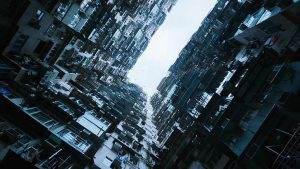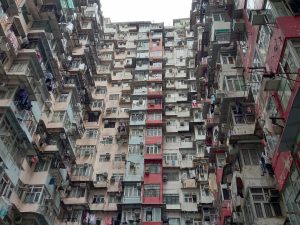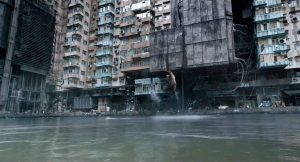GHOST IN THE SHELL, DIR. RUPERT SANDERS (2017)
Montane Mansion, Eastern District, Hong Kong
Ghost in the Shell is a cyberpunk film released in 2017.[1] It follows the main character Matoko Kusanagi, who explores her identity through navigating the futuristic yet dystopian New Port City. Heavily inspired by the urban environment of Hong Kong, the film combines colonial architecture with international modernist style buildings, featuring high-rise post-war style buildings where the rich and powerful live, along with the run-down and traditional buildings, chock full of billboards and futuristic holograms.
For a film that is all about the future, it features a huge swath of the past, from the 50s Hong Kong-style billboards to the narrow streets that run between old factory buildings. One of the film’s most famous fight scenes takes place near a series of interconnected ghetto buildings akin to Montane Mansion, an imposing and overwhelming structure to look at, while a backdrop of high-rise buildings with a glassy exterior similar to the Central cityscape can be seen at the other side. This scene perfectly melds every bit of Hong Kong together, the culture, the spaces, and the people. While the skyscrapers on the other side represent the future, the ghettos and abandoned buildings symbolize the past the city cannot escape, clashing and combining to form Hong Kong’s identity, reflecting Matoko’s conflicts of deciding her own identity. Moreover, when the real Montane Mansion comes up on screen, its monstrous size and density is no less powerful than the one in real life, the imposing aura of the densely packed blocks are only exaggerated as the camera pans up to see the sky, half blocked.
Not only does the film uses architecture as a lens to explore identity, it also narrates the grim reality of how corporations and those in power dictate how the city is created, in turn affecting how people live, and finally affecting the identity they take on. Many parallels could be drawn between the characters and the spaces they live in, such as how the rich and powerful live in high-rise futuristic buildings with lifeless and blank glassy walls, symbolizing the emptiness inside them.
Despite the new and futuristic high-rise buildings dominating most of the city, the colonial-style buildings and run-down ghettos still stand, reminding the audience how long they’ve stood and the people who once inhabited these spaces. Furthermore, not only did the film focus on the large buildings, but it also included a lot of details on these pieces of architecture, such as billboards, signs, traffic lights, which is what gives Hong Kong its lively feel, recreating the familiar but overwhelming environment. In contrast, the futuristic high-rise buildings all exhibit the same cold blue sheen and are similar to one another, making it boring and bland to look at when compared to the ghettos and run-down buildings of the past.
Hong Kong is perhaps the most fitting city for this film, as it is all about the conflicted relationship of the new and old, similar to the film’s exploration of humanity among technology, and the components that make up our identity. What better place to explore one’s identity, than a city that has a conflicted, ever-changing one of its own?
— Bertin Tong Ho Yin 3035745130


- Left: Montane Mansion as seen in the movie, although considered ancient compared to the futuristic buildings, it still exhibits an imposing aura Right: Montane Mansion in real life as comparison


Left: The other side of the water, showing the futuristic high-rise buildings, symbolizing the modern and international part of Hong Kong Right: The side showing the older buildings, inspired by Montane Mansion’s dense but uniform layout
Note
- Ghost in the Shell (2017) is an adaptation of the original made in 1995, the new version loosely follows the original.
Appreciate your take on how Hong Kong is utilised loosely to portray, in your words, “conflicted relationship of the new and old” in the film and how the topic of identity is prominent. You could explore and elaborate more on this point to better pose your argument. Were there more ways the film utilised architecture as an analytical tool for “identity”? You also highlighted the role of market power in the spatial production of the city. It could be constructive to build upon this notion as well. Try to relate your analysis to one of the key ideas we have discussed in the class that will help you read through the site and build your argument. Also, remember to put a proper reference to your writing. The citation must be incorporated in the essay, both for cited text and images which are not yours.